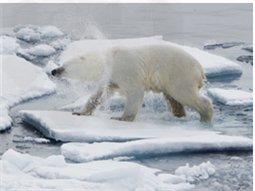阅读理解.
A nearly ice-free Arctic Ocean inthe summer may happen three timessooner than scientists
have assessed.New research says the Arctic might lose

most of its ice cover in summer in as few as 30 years insteadof by the end of the century.
The amount of the Arctic Ocean covered by ice at theend of summer by then could be
only about 1 million squarekilometers. That's compared to today's ice extent c范围)of4. 6
million square kilometers. So much more open watercould be an advantage for shipping
and for extracting(开采)minerals and oil from the seabed, but it raises the questionof
ecosystem change.
While the Intergovernmental Panel on Climate Change in 2007 assessed what might
happen in the Arctic in the future based on results from more than a dozen globalclimate
models, two researchers said that the dram4tic dropsin the extent of ice at the end of
summer in 2007 and 2008called for a different approach.
Out of the 23 models now available, the newpredictions are based on the six most
suited for assessing sea ice, according to Muyin Wang, a climate scientist in a university
of Washington, and James Overland, an oceanographer. Wang and Overland sought
models that best matched what has actually happened in recent years,because, "if a
model can't do today's conditions well, howcan you trust its future predictions?" Wang
says. "
In recent years the combination of unusual warmtemperatures from natural causes
and the global warmingsignal have worked together to provide an earlier summersea-ice
loss than was predicted when scientists consideredthe effects from human-caused
carbon dioxide alone," saysOverland.
Scientists don't expect the Arctic to be totally ice free,figuring that ice still will be
found along northern Canadaand Greenland where powerful winds sweeping across
theArctic Ocean force ice layers to slide on top of each other,making for a very thick
ice cover.
1. The main idea of this passage is supported by
.
A. the theory that has been proved
B. opinions from government officials
C. examples that were provided by the author
D. researchers' assessment of the global climate models
2. Which statement do the researchers seem to agree with?
A. That the ice in the Arctic Ocean will disappearcompletely in 30 years.
B. That there will be a very thick ice cover in northern Canada.
C. That the sea-ice loss was the effect of the unusual climate change.
D. That the temperature will be very low in the futurebecause of the sea ice.
3. How many models was the new prediction made by Muyin Wang and James Overland based on?
A. 3
B. 6
C. 12
D. 23
4. The author writes this passage to tell readers
_.
A. how to prevent global warming
B. the cause of global warming
C. the new research about the Arctic sea-ice
D. how to do research with models
.